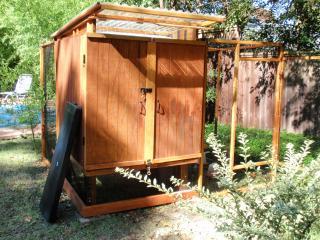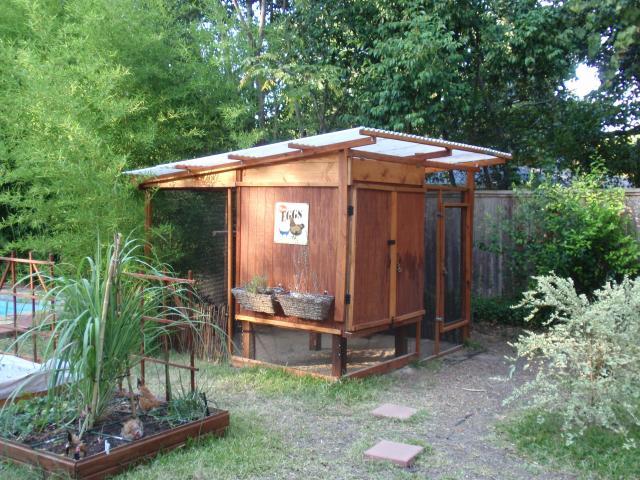Consider making the coop a little taller. Here's why: you will want to put a roost above floor level, right? Add the height of a chicken to that, and you'll want the bottom of your vent to be above this height so you can leave the vent open (or partially open) in winter without having cold drafts blowing on the birds as they roost (that's bad). You'd have to put your roost very low in a coop only 4 feet tall in order to accomplish this (unless your chickens are very short).
One thing you could do is make the shorter end of your coop 4 feet, and the taller end of your coop something taller, say 5 1/2 feet or so.
Another idea: make a second vent at the top of the back (lower) wall, so in summer you can get cross ventilation and breeze blowing over your chickens as they roost...which in hot weather is a good thing. You can have an awning style flap for both vents to open and close as needed.
You might want to rethink putting exterior nestboxes under the eave on the lower side of the roof, though. You'll be standing in runoff from the roof on rainy days to collect eggs.
About door placement: if you put the access door on the short side, you aren't going to be able to reach all the way into the back of the coop (8 feet). But if you put access doors on the long side (especially if you make them very wide), you will be able to reach the back of the coop...unless you make the legs too tall for you to reach.
I have a small, 4' by 4' coop in a similar design:

One side opens up:

The run attached to this coop was originally not roofed, which I regretted. So I added a roof later, botched the job, then finally reroofed the whole thing properly (well, more properly) this spring.

I use plastic lidded storage bins (and a covered cat litter box) as nestboxes rather than fixed, wooded ones. Mites can hide in crevices in wood, and there's no really easy way to clean them out. With my plastic bins, I just take the bin over to the composter, dump out the shavings, dust the bottom of the box with poultry dust and add fresh shavings. It's so easy I do this every week in the summer time (prime mite season).
When I had broody hens last spring, it was very easy to manage them in portable nestboxes. They settled in, and I was able to move them to separate quarters simply by picking up the box they were in. They never budged.
One thing you could do is make the shorter end of your coop 4 feet, and the taller end of your coop something taller, say 5 1/2 feet or so.
Another idea: make a second vent at the top of the back (lower) wall, so in summer you can get cross ventilation and breeze blowing over your chickens as they roost...which in hot weather is a good thing. You can have an awning style flap for both vents to open and close as needed.
You might want to rethink putting exterior nestboxes under the eave on the lower side of the roof, though. You'll be standing in runoff from the roof on rainy days to collect eggs.
About door placement: if you put the access door on the short side, you aren't going to be able to reach all the way into the back of the coop (8 feet). But if you put access doors on the long side (especially if you make them very wide), you will be able to reach the back of the coop...unless you make the legs too tall for you to reach.
I have a small, 4' by 4' coop in a similar design:

One side opens up:

The run attached to this coop was originally not roofed, which I regretted. So I added a roof later, botched the job, then finally reroofed the whole thing properly (well, more properly) this spring.

I use plastic lidded storage bins (and a covered cat litter box) as nestboxes rather than fixed, wooded ones. Mites can hide in crevices in wood, and there's no really easy way to clean them out. With my plastic bins, I just take the bin over to the composter, dump out the shavings, dust the bottom of the box with poultry dust and add fresh shavings. It's so easy I do this every week in the summer time (prime mite season).
When I had broody hens last spring, it was very easy to manage them in portable nestboxes. They settled in, and I was able to move them to separate quarters simply by picking up the box they were in. They never budged.
Last edited:







